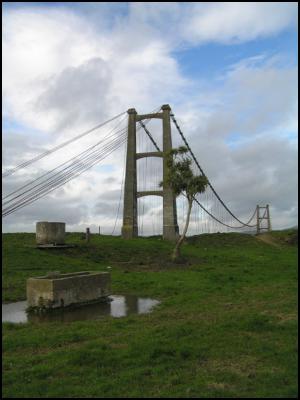Recognition for Historic Bridge and Flaxmill
.
Recognition for Historic Bridge and
Flaxmill

The last remains of a once thriving flax industry in the Manawatu and Horowhenua areas have been registered as a Category 1 historic place by the New Zealand Historic Places Trust (NZHPT).
The concrete remains of the Tane Hemp Company Limited Suspension Bridge and Flaxmill is a prominent landmark on the Manawatu River at Opiki. Completed in 1917-18, the bridge and flaxmill were part of New Zealand’s largest commercial flax industry.
NZHPT Historian Karen Astwood says flax fibre, one of New Zealand’s earliest export products, made a key contribution to the national economy.
“There were many flax growing regions in New Zealand, but the Manawatu and Horowhenua were notable. In particular, the Makerua Swamp stretching between Linton and Shannon was an important centre, and its production peaked during World War One.”
Members of prominent local flax industry families, the Seiferts and Akers, combined forces with other investors in 1915 to form the Tane Hemp Company Limited. Access to the local railway station was problematic, so roads through the swamp and means of crossing the Manawatu River were soon devised. This included the company’s significant investment in a suspension bridge, constructed in reinforced concrete, an early use in bridges.
Designed by well-known bridge builder Joseph Dawson, it was one of the longest main span bridges ever constructed in New Zealand.
A devastating flax disease compounded a post-World War One slump in demand for flax fibre and by the early 1920s the Tane Hemp mill had closed like the majority of its local counterparts. The mills were demolished and the swamp drained to create farmland, with the suspension bridge passing into sole Akers family ownership.
After the collapse of the flax industry, the bridge gained distinction as the only privately owned toll bridge in this country’s highway network. In 1969, a replacement state highway bridge was constructed and the decking of the suspension bridge was removed.
“The suspension bridge and the flaxmill remains are landmark structures. They are the only significant traces of a formerly defining regional industry,” says Ms Astwood.
The registration report is available to view online at: www.historic.org.nz/TheRegister
ends


 Gordon Campbell: On The Government’s Latest Ferries Scam
Gordon Campbell: On The Government’s Latest Ferries Scam PSA: Disappointing Govt Attack On Diversity, Inclusion In Public Service
PSA: Disappointing Govt Attack On Diversity, Inclusion In Public Service NZ Labour Party: Govt Health And Safety Changes Put Workers At Risk
NZ Labour Party: Govt Health And Safety Changes Put Workers At Risk Amnesty International Aotearoa New Zealand: Democracy At Risk
Amnesty International Aotearoa New Zealand: Democracy At Risk Walk Without Fear Trust: New Sentencing Reforms Aimed At Restoring Public Safety Welcomed
Walk Without Fear Trust: New Sentencing Reforms Aimed At Restoring Public Safety Welcomed Rio Tinto & NZAS: Archaeological Project Underway From Historic Excavations At Tiwai Point
Rio Tinto & NZAS: Archaeological Project Underway From Historic Excavations At Tiwai Point New Zealand Deerstalkers Association: NZDA Urges Hunters To Prioritise Safety This Roar Season
New Zealand Deerstalkers Association: NZDA Urges Hunters To Prioritise Safety This Roar Season


